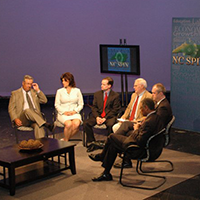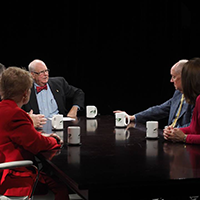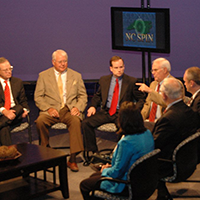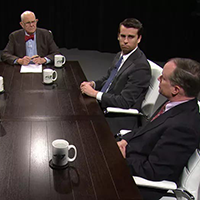Doing the math on a big gas tax increase
Published February 17, 2015
by Bruce Siceloff, News and Observer, February 16, 2015.
Yes, it is a gas tax cut, as Senate Republicans call it.
And yes, as they are determined not to call it, the Senate bill unveiled last Tuesday and quickly adopted Thursday is – at the same time – a big increase. It could push North Carolina’s gas tax close to the nation’s highest.
House members are being asked this week to approve the legislation with Senate-like speed. Let’s help them come to grips with this bundle of contradictions.
Let’s do some math.
North Carolina covers 70 percent of its road and transit costs with the tax – currently 37.5 cents (state) plus 18.4 cents (federal) – on every gallon of gas. But our cars burn less and less gas per mile nowadays, so gas-tax collections are flatlining.
The state Department of Transportation offers a conservative projection that present revenue sources will fall at least $34 billion short of North Carolina’s needs by 2040.
Shelf-loads of studies diagnose our transportation ills and prescribe healthy alternatives to our doomed dependence on gas taxes. Partial remedies could include a heavy levy on big trucks that pound our pavement (worth $300 million a year in Oregon) and a hike in our low 3 percent tax on car sales (an added 2 percent would rake in $440 million a year).
Never mind any of that stuff. Senate Republicans have decided to go their own way. And, baby, they’re sticking with the gas tax.
The Senate gas-tax recipe is one of a kind. Its first ingredient is a cherry on top: a 2.5-cent reduction in the tax rate, to take effect March 1.
500 DOT jobs
When Democratic Sen. Dan Blue of Raleigh asked Republican Sen. Bill Rabon of Southport in a committee meeting last week to consider postponing any tax cut until July, Rabon replied that a delay would cause “difficulty in one of the chambers in passing such a bill.”
To pay for this sweet taxpayer treat, 500 DOT workers would have to give up their jobs in March. Gov. Pat McCrory expressed concerns about the prospective layoffs last week.
The new state tax would be set at 35 cents. This rate would become a floor in future years, to prevent the tax from falling lower.
It is this new minimum tax rate that has drawn fire from the Republicans’ anti-tax right. Americans for Prosperity points to the 35-cent floor and calls the measure a tax increase – since it prevents the tax from falling in July to a projected rate of about 30 cents. The tax rate is readjusted periodically according to a legislative formula that rises or falls with changes in wholesale fuel prices, which have plunged in recent months.
The Americans for Prosperity critique overlooks a more substantial tax increase that would follow in future years. Under the Senate’s new accelerated formula, when fuel prices rise again, the gas tax rates would rise faster and higher than before.
Now, without apology, we get to the math.
Under current North Carolina law, the gas and diesel fuel tax rate is the higher of two numbers: either 21 cents or 17.5 cents plus 7 percent of the average combined gas and diesel wholesale fuel price. The average is calculated over six months.
Under the Senate Republican bill, the tax would be lifted to a higher minimum rate, 35 cents. The wholesale fuel multiplier would also be pushed to a higher level, 9.9 percent.
During brief floor debate last week, Senate Republicans argued that there’s no way to know how high the tax will rise in future years, because it is hard to predict how high wholesale fuel prices will rise.
“History has shown us that this is a very volatile calculation,” said Sen. Ralph Hise of Spruce Pine. “Quite frankly, we have no idea of the revenues” the tax will produce.
Economists for the legislature, DOT and McCrory’s Office of State Management and Budget do have an idea, based on the federal government’s fuel price projections. They say the Senate proposal would generate an additional $1.2 billion for DOT by 2019, or more than $250 million a year.
But Barry Boardman, the legislature’s chief economist, agrees with Hise that “it’s highly volatile when you try to forecast what those prices are going to look like in two or three years.”
‘Revenue stability’
Wherever the fuel prices go, higher or lower, gas taxes would be higher under the new Senate proposal than under the state’s present formula. According to the Road Worrier’s calculator, if the Senate plan was current law, North Carolinians would be paying a 46-cent state gas tax right now.
Only Pennsylvania, at 50.5 cents, has a higher tax rate than that. (Our present gas-tax ranking among the 50 states: sixth highest.)
When DOT engineers updated their draft 10-year plan for road improvements in 2014, they included projections for gas tax and other transportation revenues that – in light of the recent sharp drop in fuel prices – now appear to be overly optimistic. When Senate Republicans decided to replace that 7 percent fuel-price multiplier in the gas tax formula, they picked a higher number – 9.9 percent – that economists said would boost revenues enough to reach DOT’s original projections.
Governors and legislators elsewhere in the country, Democrat and Republican, have rolled out proposals in recent months for new taxes and higher taxes to help their states catch up with road, bridge and transit needs.
North Carolina’s Senate Republicans want to raise more money for transportation, too, but they don’t want to call it a tax increase. Their phrase in floor debates and news releases last week was “revenue stability.”
Now let’s see what House members think.







